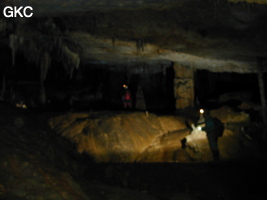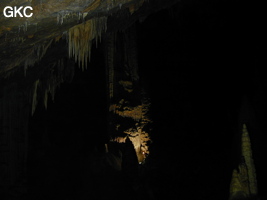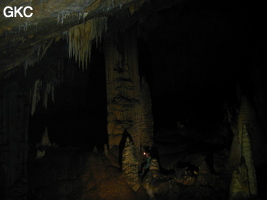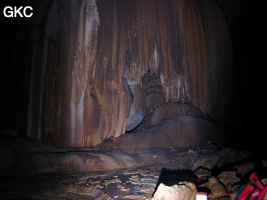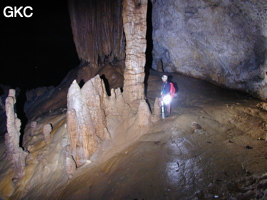
Grottes et karsts de Chine
Sur les traces de Xu Xiake
 Feilongdong - 飛龍洞
Feilongdong - 飛龍洞
Détail31/12/2024 11:57:15
Autres noms : Grotte Du Dragon Volant , Xingchang Dong
Province, Préfecture, District :
Guizhou 贵州省, Liupanshui Shi 六盘水市, Liuzhi 六枝
Latitude Nord - Longitude Est :
26.395001 - 105.22856
Altitude (m) : 1655
Développement (m) : 544
Profondeur (m) : 90
Profondeur - / + (m) : 90 /
Volume (m3) :
Géologie : Permien
Carte
Description 2
L'entrée de Feilongdong est une petite dolline de 30m par 20m. A droite, une descente sur un pierrier sec et la galerie bute sur concrétionnement.
A gauche, il faut descendre à quatre pattes sur une dizaine de mètres avant de déboucher sur "La salle du brouillard", en fait c'est une énorme galerie (30mx15m) que l'on suivra jusqu'au terminus de la cavité. Le parcours s'agrémente progressivement de draperies, gours, colonnes, stalagmites et stalagtites du plus bel effet. Après une courte interuption, où l'on remo
Analyse :
528 caractères - Lu 169 Fois
Geographical position: The entrance of the cave lies in a smaller collapse doline which is located on 1720 metre above sea level, NW from the Xingchang village, on slope above karst polje.
Basic data about the cave:
Length: 541m
Depth: 99m (between highest and low- est points of the cave)
Horizontal length: 510m Stretching in E-W direction: 330m Stretching in N-S direction: 90m
Description of the cave:
On the bottom of the collapse doline with diameter of 20 m are two entrances, one of the eastern longer passage and the other of the shorter western passage (Fig. 2.5.5.).
Eastern passage:
The narrow and low entrance in the east- ern passage becomes after few metres widely opened and follows the bedding plane parting dip under the inclination of 200. In this part numerous fossils (especially crinoid stems) jut out of the weathered cave walls. At the beginning ceiling is lower than 1m, but highness of the passage monoto- nously increases and after 100m passes into largest hall in the cave (50X40X20m). On the bottom of the hall is an entrance that leads into series of short vertical steps that end (continue) with narrow muddy chan- nel (unmeasured) 30m below the hall. Channel is already bellow the level of the flooding waters.
The hall is on the eastern side break off with flowstone barrier. Up to 10m high and up to 25m wide passage is covered with flowstone and proceeds towards NW from the hall. After 100m channel turns towards SE and continues with flowstone slope. At the bottom of the slope is the most remote and the deepest measured point of the cave. The final parts of the cave are beautifully decorated by numerous and various forms of flowstone.
Western passage:
Western passage is developed along ver- tical E-W oriented fissured zone. Ten metre high entrance is triangular in shape and the walls diverge into fissure on the roof. The passage steeply descend toward W under the inclination of 350. The bottom is cov- ered by gravels and the walls are bare.
Chen Xiaoping, Franci Gabrovsek, Huang Chuxing, Jin Yuzhang, Martin Knez, Janja Kogovsek, Liu Hong, Metka Petric, Andrej Mihevc, Bojan Otonièar, Shi Mengxiong, Tadej Slabe, Stanka Sebela, Wu Wenqing, Zhang Shouyue, Nadja Zupan Hajna- South China Karst I 1 Karst Studies of Yunnan 2 Cave Studies in W Guizhou (1998)
247p- Published by : Znanstvenoraziskovalni center Slovenske akademije znanosti in umetnosti, 247p., 1998
Analyse :
Members of the Karst Research Institute ZRC SAZU, Postojna, and members of the Yunnan Institute of Geography and Institute of Geology of the Chinese Academy of Sciences gathered the results of karstological researches of south Chinese karst in two projects adopted by an agreement on scientific and technological cooperation between the Government of the Republic of Slovenia and the Republic of China. The projects Karst Environmental Protection and Exploitation of Cave Resources and Study of Stone Forest Genesis, Function and Structures of the Underground Karst Aquifers in Lunan, Yunnan Province were going on from 1995 to 1997. They were made feasible by the Slovene and Chinese Ministry of Science and Technology and supported by Yunnan Provincial Science and Technology Commission, Administration of Stone Forest, and The Ninth Township Scenic Spots and Historical Sites Administrative Bureau, Yiliang County. The researches were carried out near Liupanshui, the western part of Guizhou, in karst between the mountains in Guizhou and Yunnan Plateau, in the area of Lunan stone forests and in cone-karst at Xichou, Yunnan.
1987 caractères - Lu 338 Fois
Bibliographie 2
"MAIRE, Richard; BARBARY, Jean-Pierre; ZHANG, Shouyue; VANARA, Nathalie; BOTTAZZI, Jean"
Karstologia Mémoires, n° 9 : 562 p.
"Cet ouvrage synthétise les travaux des six expéditions organisées par le P.S.C.J.A. dans les provinces chinoises du Yunan, Guizhou et Liaoning entre 1997 et 2001. Il est organisé en trois livres traitant de : 1) les résultats des explorations, contenant inventaires, descriptions, cartes et topographies des 144 cavités explorées ; 2) l'environnement karstique, études approfondies sur des thèmes scientifiques ciblés ; 3) la spéléologie en Chine, sous l'angle historique et avec le récit des dernières expéditions. Les karsts sont ainsi numérisés depuis l'échelle géographique à microscopique selon des critères d'analyses aussi diversifiés que la géomorphologie, les indicateurs du milieu, le fonctionnement hydrochimique, l'écologie, le développement local et l'histoire de la spéléologie. (BJ)."
Source :
Chen Xiaoping, Franci Gabrovsek, Huang Chuxing, Jin Yuzhang, Martin Knez, Janja Kogovsek, Liu Hong, Metka Petric, Andrej Mihevc, Bojan Otonièar, Shi Mengxiong, Tadej Slabe, Stanka Sebela, Wu Wenqing, Zhang Shouyue, Nadja Zupan Hajna- South China Karst I 1 Karst Studies of Yunnan 2 Cave Studies in W Guizhou (1998)
247p- Published by : Znanstvenoraziskovalni center Slovenske akademije znanosti in umetnosti, 247p., 1998
Members of the Karst Research Institute ZRC SAZU, Postojna, and members of the Yunnan Institute of Geography and Institute of Geology of the Chinese Academy of Sciences gathered the results of karstological researches of south Chinese karst in two projects adopted by an agreement on scientific and technological cooperation between the Government of the Republic of Slovenia and the Republic of China. The projects Karst Environmental Protection and Exploitation of Cave Resources and Study of Stone Forest Genesis, Function and Structures of the Underground Karst Aquifers in Lunan, Yunnan Province were going on from 1995 to 1997. They were made feasible by the Slovene and Chinese Ministry of Science and Technology and supported by Yunnan Provincial Science and Technology Commission, Administration of Stone Forest, and The Ninth Township Scenic Spots and Historical Sites Administrative Bureau, Yiliang County. The researches were carried out near Liupanshui, the western part of Guizhou, in karst between the mountains in Guizhou and Yunnan Plateau, in the area of Lunan stone forests and in cone-karst at Xichou, Yunnan.
Source :
Images 26
Topographie 1

Source : IZRK ZRC SAZU
Expédition 2
Cette grotte a été identifiée ou explorée au minimum par cette (ces) expédition (s) :
Recherche



